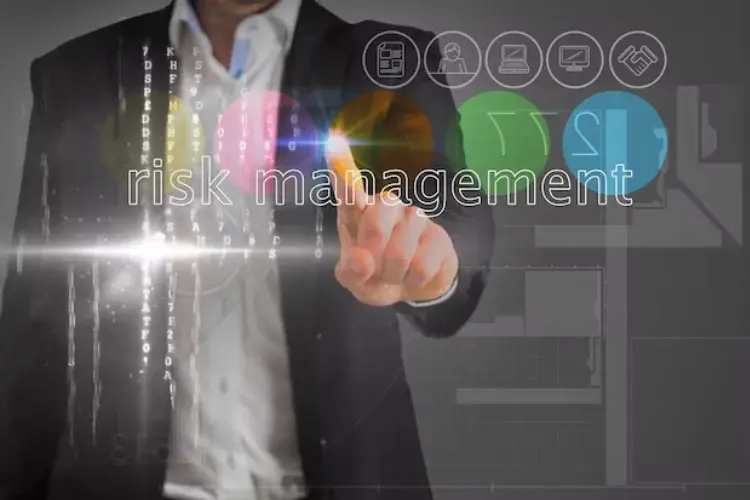What Is Cyber Risk Management?
Cyber risk management has become an unavoidable reality, challenging individuals and businesses to operate smoothly. Whether it’s data breaches, insider threats or other vulnerabilities, the potential for harm is ever-present for businesses. The best cyber risk management strategy can secure the businesses in the long run.

Cybersecurity threats can knock critical technical systems offline and online or even wreak havoc in multiple ways. A sustainable process of keenly identifying, prioritizing, managing and monitoring risks to information systems is inevitable.
This article seeks to provide valuable insights into its key aspects to achieve consistent and effective outcomes. Let’s dive in!
Cybersecurity Risk Management: A Comprehensive Overview
Table of Contents
Before you jumpstart, let’s grasp the lay of the land – cyber risk management. The internet is a vast ocean where cybersecurity assists you navigate the complexities. Cyber risks propagate in various forms and without proper management, business continuity can be thoroughly challenged. Enterprise cyber risk management is crucial to pinpoint the most critical threats and select the right cyberattack solution.
Unfortunately, companies often don’t understand that pouring an unbalanced percentage of the budget in the name of risk management only results in the drainage of resources. The best cyber risk management plan covers a holistic perspective to address the risks comprehensively.
Under the supervision of a professional security team, it is convenient to produce an integral, well-coordinated, well-orchestrated, and consistent management solution. Let’s explore the key actionable components of risk management that you must keep in mind:
- Building robust policies and tools to assess vendor risk actively
- Quick pointing out of emergent risks, such as new security protocols with business impact
- Identification of internal security gaps, such as lack of 2FA method
- Risk mitigation, possibly through launching training programs for IT security teams or new protocols and internal controls
- Thorough audit and deep testing of the overall security posture for data protection and safety of other confidential information
- Document all the vendor risk management details and security levels for regulatory examinations or to appease prospective customers
What are Potential Cybersecurity Threats?
Before heading to build and apply strategic planning for cyber risk management, businesses need to reflect on potential vectors that can be exploited in order to breach security, cause irreparable damage to the organization, or dubiously exfiltrate data dodging the security standards.
As there are multiple storm clouds on the horizon before the rain hits the ground, there are multiple threats out there in cyberspace. Some common threat categories facing modern companies include:
- System Failure: A failed system can jeopardize sensitive data. It may fall prey to data loss ending up in operational disruption. Integrate your mainstream business applications and systems with high-quality equipment having redundancy in place to promise high accessibility with timely support.
- Adversarial Threats: This includes all third-party vendors, deep insider threats, well-established hacker collectives, ad hoc groups, highly privileged insiders, corporate espionage, and nation-states. Above all, malicious software like malware is developed by any of these threat entities. Large companies establish a security operations center with graded tools to mitigate these alarming threats.
- Human error: Company staff may accidentally download any malware or get unknowingly tricked by social engineering schemes like phishing tactics. Any little misconfiguration in the storage space of the system may disclose sensitive information. Professional employee training programs and effective security access controls can banish these threat flows. For instance, use password managers and proactively monitor systems to avoid misconfigurations.
- Natural disasters: These include floods, earthquakes, fires, hurricanes, and sudden lightning, which can cause damage comparable to a cyber attacker. A natural calamity can disrupt systems, leading to data loss, service interruptions, or even the complete collapse of an organization’s assets. Dispersing operations across physical locations or using distributed cloud services helps reduce the risk of damage from such events.
Critical Threat Vectors Impacting Organizations
Below are some of the critical threat vectors that significantly impact the majority of organizations:
- Data Leaks: Dangerous malicious actors or unexpected cloud misconfiguration may culminate in the leakage of personally identifiable information (PII) and other vulnerable data.
- Unauthorized Access: It may be the result of staff error or any ransomware risk where malicious attacks hijack the system for nasty gains.
- Service Disruption: System downtime may affect clients and market reputation, causing hefty financial losses. It may be a human mistake or the outcome of a DoS attack.
- Loss of Data: The mishandling of the system, wrong configuration or backup processes may cause sensitive data loss or unintentional deletion.
- Misuse of Information by Legit Users: It may occur at the helm of an insider threat by misusing information in the form of altering, deleting, or using it without legitimate access.
Cyber Security Risk Management Plan
There are different data risk management frameworks that serve as an integral part of cyber risk management plans. These frameworks involve the proper identification, assessment, and mitigation of significant risks and cyber threats, primarily related to IT systems, networks, and data.
In today’s cybersecurity landscape, your enterprise systems are perpetually targeted by attackers. These potential cyber hazards can compromise the integrity, privacy, and accessibility of your sensitive information, posing significant risks to business operations.
Let’s decipher the key components of the plan.
- Risk Identification: The primary step is the identification of key cyber threats and vulnerabilities that could compromise an enterprise’s IT resources. This significantly involves the company’s IT infrastructure, confidential details and the vulnerabilities associated with various systems and technologies.
- Risk Assessment: This step involves the thorough risk analysis and risk evaluation of all the risks discovered during the identification phase. It helps the seamless execution of cybersecurity risk assessments while understanding their potential impacts in the form of vulnerability analysis, assessment, and determination of associated risk levels.
- Risk Mitigation: This step requires the implementation of cyber risk measures to reduce any identified risks from causing harm. These measures include the implementation of security controls, safety encryption, efficient access controls, and other measures against cyber threats.
Sustaining Cybersecurity Through Proactive Measures
Maintaining robust cybersecurity requires proactive steps, including continuous monitoring, risk mitigation, employee education, and strict compliance to safeguard systems and data.
- Incident Response and Recovery: It is better safe than sorry. Companies need to build and enforce proper response and recovery plans to manage email security matters and counter cyber incidents. These plans are precise and accurate to timely detect, contain, eradicate and recover the systems for business stability.
- Monitoring and Review: Cyber risk management doesn’t stop after implementing a strategy. Continuous monitoring is essential to detect and respond to emerging threats in real time. This proactive approach ensures systems stay updated and anomalies are addressed before causing harm.
- Compliance and Governance: Ensure your organization fully complies with the IT-related security regulations and standards before you hit any bumps in the digital world. These compliance protocols involve framing governance structures to guide organizations for effective cybersecurity.
- Employee Training and Awareness: Last but not least, educating your staff using phishing simulation programs is the best cyber security practice. Guide them about the potential cyber risks that can impact security hygiene. Don’t forget to inform them about human behavior that can play a vital role in posing cyber risks.
What are Cyber Risk Management Frameworks?
The emerging threats require you to keep your finger on the pulse of your company’s cybersecurity health in the face of adversity. There are multiple cyber risk frameworks each of which offers key standards organizations can utilize to identify and actively mitigate risks. The IT security team leverages them to upgrade the security posture of the company. Some of the frameworks are listed below.
- FAIR Framework: This analysis helps to measure, analyze, and absorb information-based risks. The prime objective is to guide companies to make well-informed decisions.
- NIST CSF: With the National Institute of Standards and Technology Cybersecurity Framework (NIST CSF), companies can get the map of activities and results with the core components including protect, detect, assess, respond, and restore.
- DoD RMF: This framework is for assessing and managing cyber risks, following the core steps of arranging, selecting, executing, assessing, authorizing, and monitoring.
- ISO 27001: The international standardization has provided this framework to systematically tackle all the risks posed by information systems.
At the end, there is no room for rest in the modern pursuit of cyber risk management. Whether you are at remote work with unsecured networks or other vulnerabilities multiplying by every minute, you require effective cybersecurity asset management. Modern tools, third-party risk management frameworks and professional cybersecurity service providers continue to assist you in the battle to manage ever-growing IT risks and maintain stability across industries.
Facing IT Challenges in Chicago?
Schedule a consultation with our expert team to get the help you need!
Related Articles

Risk-free use of Artificial Intelligence in Cybersecurity

Secure Supply Chains with Disaster Recovery Solutions


